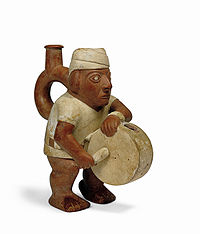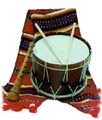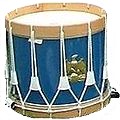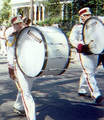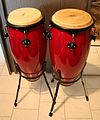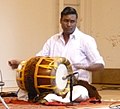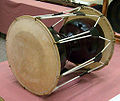Drum
A drum or tympanum is a percussion instrument with an indeterminate sound, belonging to the family of membranophones according to the Hornbostel-Sachs classification system. of a soundboard, which is usually cylindrical in shape, and a membrane called a head, which covers the opening of the box. Some types of drums have heads on both sides. The sound is obtained by striking the instrument on the head with the hand or with drumsticks. The box is also usually percussed.
On the other hand, and especially in colloquial language, the word drum is also applied to other percussion instruments that are not membranophones but idiophones; Examples are the cutting drum or wooden drum, which is actually an empty trunk; or also, in English, the steel drum (translated: steel drum) which is also an idiophone. From this it could be deduced that the fact of percussion is more decisive for a drum to be considered than the fact that it has vibrating membranes.
Uses
Drums are generally played by striking one or two sticks or drumsticks. A wide variety of sticks are used, including wooden sticks and sticks with soft felt beaters on the end. In jazz, some drummers use brushes for a softer, quieter sound. In many traditional cultures, drums have a symbolic function and are used in religious ceremonies. It is an instrument used in most rock bands.
Drums are frequently used in music therapy, especially hand drums, due to their tactile nature and ease of use by a wide variety of people.
Drums even acquired divine status in places like Burundi, where the karyenda was a symbol of the king's power.
History
The Greeks called this instrument tympanon or typanon, and the Romans tympanum.
Homer did not mention the drum in either the Iliad or the Odyssey. In Euripides' The Bacchae, Bacchus commissioned his henchmen to capture the drums used by the Phrygians. He affirms that these drums were & # 34; invented by me and Rhea or the great mother of the gods, Cybele & # 34; . In another passage he says that the Corybantes invented it for him. Among the Greeks it was believed that the Phrygians were the inventors of the drum while the Romans thought that it was the Syrians. The most probable thing seems to be that the Greeks copied some drum from the Asians and that from there it would pass to the Romans.
For the drums bull skins were used but more frequently donkey skins, as Gaius Julius Phaedrus mentions in his fables, in the fourth book. The drum consisted of a circle of wood or metal covered with a skin that gave it the shape of a sieve. The drum was sometimes played with drumsticks, but the most common was by hand and in the same way as the tambourine is played, to which the drum of the ancients was very similar. To produce a louder sound, some metal plates were added as well as bells and rattles. The tympanum became the symbol of feminization because it was used mainly by men consecrated to Cibeles. The eardrum players were kept by women of bad habits. One of the things that San Justo wanted to banish from banquets were the cymbal and tambourine players.
In no ancient monument is a drum with two skins seen, although there are texts about them in works from the Late Empire. Isidoro de Sevilla wrote that the symphony was an instrument that was played alternately or at the same time on both sides and that the mixture of the two low and high sounds formed a very pleasant harmony. Prudencio already mentioned that with the symphony the signal to attack was given in the Battle of Actium.
The etymology of the name seems to indicate that the knowledge or use of this drum is older than is generally believed, that is, from the time of the wars of the Saracens or Moors. The Moors were the first to use these instruments in their armies, which they called al-drum. The timpani, an instrument typical of the ancient cavalry and preserved in some places in Spain at popular festivals, are possibly also an Arab invention.
Some historians believe that the Chinese have used the drum since time immemorial. Instruments similar to the drum are also used in many towns in Africa.
There is no doubt that the Iberian peoples adopted the drum from the Arabs already in the Middle Ages. After having been suppressed during the reign of Amadeo de Saboya, its use was restored in 1893 by General López Domínguez.
In the Andean cultural area, drums were used to accompany ceremonies and parties. Instruments like the tinya were quite common. On the southern coast, the Nazca developed their own typical drum, which was characterized by its decorative and sculptural level.
Drum Types
According to the Hornbostel Sachs classification, there are two large types of drums depending on the action that is performed to make it vibrate. In the first group are the percussion drums, while in the second are the friction drums. In reality, however, the seconds are usually known as zambombas and are not considered true drums. Thus, and despite the criteria and systematic classification of Hornbostel Sachs, this section is dedicated to percussion drums (membranophones). The typology is determined by various elements such as:
- The shape of the resonator
- Depending on whether it is a single drum or drum groups (partners, usually)
- Depending on whether you touch your hands or some type of backets
- Depending on how the membrane is fixed and tightened
Due to the shape of the resonator, the types that appear are:
- Bol-shaped drums, container. They are the only ones that can give a certain sound, the only ones that can be refined accurately. In primitive cultures, those made of ceramics abound. In other more advanced cultures it is usual to find metal drums. The orchestral timbals are found within this group. Beyond these, they are very common in Central Africa, in Ivory Coast and, in general, across the continent (Sudan, Ghana, etc.). One of the simplest and most widespread variants in Africa uses a pumpkin as a resonator. Among the bandages is very used the drum ngoma. In America they are found in Peru, in New Mexico and in the peyote culture. It is also common in India: one of the two drums that integrates the board is of this type and is made of metal. The pair of bowl drums that is common in the Arab world and which is known with the name of naqara – and which has a rich medieval European iconography – is the predecessor of the orchestral timbales that developed in Europe from the century XV.
- Tambors that some call cylindricals and others, tubulars. They're the most abundant. They can have a membrane or two, and can be opened or closed by its opposite end to that of the single or main membrane. According to the authors that we are following, some types that have a resonator that is not exactly cylindrical are also classified within this group, while other authors consider them as separate groups. This denomination comes from the fact that most drums have a circular membrane; that is why those who have the right walls are also considered cylindrical, although the shape of the membrane is not exactly circular, but rather triangular (such as the case of the Isigubu of South Africa) or even square. Among these are the following:
- Exactly cylindrical drums. It is the most common image of what is a drum for most people, in the collective imaginary, and corresponds to the typology of most drums used in European music, both in the traditional, and in the popular and in the classic. In the first group is the drum, which is played along with the flabiol to the copla, the tabal that accompanies the dulzain in Valencia and most drums accompanying the flutes of three holes. Among the seconds, most of the phones that are part of the battery: goliath, tomtoms, box and pump. And in the third group, all orchestral membranophones except the timbales: the box and the pump, mainly. In addition, they are also found in many other cultures: among the natives of South America and North America, across the African continent, with examples highlighted in Nigeria, Ivory Coast or South Africa. Also in Asia there are drums of this type (in Japan, in India, in Bali...) and in Oceania (in New Guinea, for example). The most common thing is that these instruments have two membranes, even though they are used to touch only one, except for those that are equipped with the cylinder in a horizontal sense and the membranes on the sides, vertically. In the West, it is the case of the fire, at least when involved in itinerant music.
Conical drums, or more precisely frustoconical, with the base having a narrower diameter than the upper part, on which it is struck. They are very frequent on the African continent. Among them there is the ntenga, from Uganda or the koboro from Ethiopia. Conical drums have also been developed in America (the batá drums of Cuba or those of the Ijca Indians, among others) to which those brought from Africa by slaves have joined in recent centuries. They are also found in Southeast Asia, for example in Java and the Nias Islands. It is common for these drums to have a single percussive membrane.
- Tambors in the form of boot or barrel, wider by the center than by the edges (the membranes), and usually with two membranes, which can be of the same diameter, if the drum has a symmetrical profile, or different diameters, if it has asymmetrical. They are especially common in Southeast Asia (Cambodia, Java...) and in India, even though there are also in Africa, South America and Japan (some drums). daiko How do I tsuri daiko o l'o-daiko. They are also among these congas, typical of Latin American music and bongos that are a popularized and more modern version.
Hourglass-shaped drums, meaning narrower in the middle of the 'cylinder' than at the ends, where the membranes are. They are especially used in West Africa and Japan. Among the former are, for example, the kalungu from Nigeria and among the Japanese the kakko, the tsuzumi and some daiko (or taiko) drums stand out.) as the huge da-daiko. There are also in the Arab world (in Iraq, Turkey, etc.) and in other areas of the Asian continent such as Korea, India or Tibet; The latter was traditionally built with two human skulls cut out and opposed, a fact that gave it magical connotations; In between, Sihi finds the drumstick attached to a string, which alternately strikes one membrane and the other when the drum is rotated rapidly. Finally, there are also drums of this type in New Guinea. Some consider the batá drums of Cuba to be in this group. Some of these drums take advantage of the fact that the central part of the instrument is rawer to concentrate a part of the strings that fix the tension of the membranes, so that by applying variable pressure on this central section, the tension of the drum can be modified. the membranes and with this the height of the sound it produces is modified. This is how the speaking drums of Nigeria produce and modulate different sounds.
Drums in the shape of a cup, or bowl or container, but with one foot. Those that currently exist in Europe, such as the tarabuka of Greece and the darbuk of Serbia, are clearly derived -both in shape and name- from the Arabic darbuka, which can be found from Morocco to the center of Asia with different shapes, decorations and materials. In West Africa this type of drum is present in Nigeria, Ghana and the Ivory Coast. In some of these countries and in the Congo there are anthropomorphic drums. They also exist in Polynesia, Hawaii, and the Marquesas Islands.
- Within this group, some additionally distinguish another subgroup: the so-called Long drums, characterized by the fact that the cylinder length is much larger than the diameter. They may have quite different forms: cylindrical, barrel, sand watch, cup, foot, etc. They are in Africa (Cameroon, Congo, Nigeria, South Africa, in America (between the Talamanca and the Chocó Indians), China, India, New Guinea, Polynesia, etc.
- Frame drums: They consist of one or two membranes linked and tensed to a simple frame that is used to being made of a thin piece of wood that configures a small cavity that adds a bit of resonance to the vibration of the membrane. Hornbostel and Sachs specify that the limit to consider a drum to be framed and not cylindrical is that the depth of the body is less than the radius of the membrane. They also note that, this would make the box to be considered a frame drum, but, as a result of cylindrical drums, it is contemplated within that group.
Usually they are circular but there are also other shapes, such as the square drums found in some areas of Spain and Portugal. Drums of these types are associated with rituals and shamanism in various cultures, such as among the Eskimos or Lapps; in these cases it is common for the membranes to have decoration of a symbolic nature. Some have a handle in line with their diameter to hold them, while others are caught directly by the frame. Some even, instead of being hit with the hand (the majority) or a drumstick (they are few), strings hang at the end of which there are some balls on the sides of the frame and opposite ones, which alternately hit a membrane and the another when the handle is rotated. This is the case, for example, of the terbang and the kelontong of Java, and drums of this type are also found in Tibet. Specimens are also found among the natives of North America, in Panama, Argentina, Serbia, India, etc.
Some types of frame drums make incisions inside the frame into which they place small metal discs, in pairs, that strike each other when the drum is shaken. In this case it is a mixed instrument, membranophone and idiophone. There are many examples, the most common of which is the Spanish tambourine. Modernly, the tambourine in many contexts is made of metal and has already lost the membrane, so it is only an idiophone. Other specimens are the reshoto and the buben, both from Russia, the tar in Turkey, and the riq, the daf common in several Arab countries.
Regarding the number of drums, despite the fact that most of them are played alone – that is, a single membranophone is considered the instrument – there are also multiple examples of instruments made up of two or more drums. Among the drums that go in pairs or in larger groups, the two most common examples are that of the drums and that of the orchestra timpani; in the first case it is about several cylindrical drums combined with some idiophones; in the second, the number of instruments that make up the ensemble has increased from the initial two that existed in the XVIII century, if we mean the orchestra, or in the XV, if we mean their non-orchestral predecessors. But it is also the case of the table of India; one of the drums is cylindrical and the other conical. This drum is part of the most common music group in that country, accompanying the sitar and establishing the felling or rhythmic principle of the composition. Goblet drum ensembles, of up to five instruments bound together, are also played in the Ivory Coast.
Other drum-type instruments are also the most common percussion instruments. Some are:
- Mazhar
- Redoblante
- Taiko
- Merry Tambor
- Tambora dominicana
- Tambor caller
- Candombe drums
- Tamboril
- Timbal
- Tumbador
- Square Tambor
- Tambor chang-ku
- Huehuetl
Varieties
Drum-type instruments are the most common percussion instruments. Some are:
- The Battery is made up of a set of drums, usually of wood, covered by two patches, one hit (at the top) and another resonant (at the bottom). These drums can vary in diameter, affecting the tone, and depth, varying sensitivity on the resonance patch. The battery can be tuned with a tuning key. The more you have the patch, the sharper the sound, and vice versa.
- The Bombo is used in the band, in the symphonic orchestra (from the century XIX and as an integral part of a battery; the latter usually measures between 18 and 22 inches (singles) in diameter, and is touched by a special pedal that carries a bush.
- The Bongon. Its origin dates back to the eastern zone of Cuba, which, together with the development of the son, reaches its definitive form and greater splendor when arriving in Havana from 1909. It's a minor percussion instrument. It is a membranophone composed of two wooden drums with a patch each, with a height difference between them usually of a fourth or fifth. The patches are stained by rings and a system of tension by keys (at the beginning they were tensioned by heat of fire or with strings or straps). The drums are attached on the side with a piece of wood, although it was formerly made with a leather strip or a rope. The drums are conical in shape and run with strokes of the palms of the hand or with drums. The smaller drum is called Male and it is placed on the left; remaining on the right the largest so-called female. It is usually placed between the knees of the performer sitting, although it is also very used on a track. The executor usually alternates its use with the Cuban cencer, usually used in the climax of the son, called the Montuno.
- The Box or redoblative, is a drum, usually of little height, with strands called aboards arranged diametrically to the lower membrane, which give it its characteristic more strident and metallic ring than the common drum. The musician who plays the box is told in turn by association box, having percussionist formation. This instrument is used in orchestras, in music bands, and is a fundamental part of the battery.
- The Caja vallenata, is made of a hollow trock of some fibrous tree, is added a patch of deer or goat skin, adjusts on the legs and carries tension rings, next to the accordion and the guacharaca, is one of the traditional instruments of the famous vallenato. It measures 30 to 40 cm.
- The Conga is a drum, usually of little height, with strands called boardns arranged diametrically to the lower membrane, which give it its characteristic more strident and metallic ring than the common drum.
- The Darbuka is a single-patch drum with a cup shape. Originally it was used to arm the resonance box and goat or fish leather for the patch, but it is also usually used wood or metal for its manufacture; currently it is common to use fiberglass or aluminum for the box and plastic for the patch. The latter is the most used today by professional musicians, since it does not affect climate conditions such as humidity, which causes the patch to lose its tension and disconnect, having to heat up to be able to execute the instrument.
- The Taiko is a Japanese drum of a diameter of 1.3 m, played with wooden pallets called bachi. Outside Japan, the term refers to the different types of Japanese drums. Tambor in Japanese is written 'wa-daiko'. Taiko also refers to the relatively recent art of Musical Ensemble of percussion Taiko (in Japanese, known as "Kumi-daiko"). Taiko is employed in many traditional festive events in Japan, sometimes being the attraction center, as in the Good Odori A traditional dance. Because of its great weight the Japanese usually leave it fixed in one place (passes the same with the piano), not to have to swallow it with great effort from one place to another. Its weight ranges between 295 and 310 kilograms. The two ends are covered by membranes, but only percussed on one side, with a thick pair of wooden decks. Those who earn a living thanks to this fantastic instrument carry it in wagons, and the most daring ones transport it behind their backs.
- The Tambori is a 12-centimeter long percussion instrument consisting of a resonance box with metal or wooden structure covered with leather pieces. It is usually used to accompany the sound of flabiol, such as in the sardana, in which it marks the rhythm.
- The Tambor is a musical instrument of serious sound percussion, which can produce dry or resonant blows. It is used by hitting the patches with a special deck or drum kit. It is formed mainly by a boiling brothel, covered by a membrane. It can be refined, so it produces certain sounds, that is, precise musical notes.
- Tinya was a typical drum of Andean civilizations, being an easy instrument to transport for one individual. He was often employed during solemn Andean events, such as parties and ceremonies. Some tiny ones were lined with textiles that exhibit exquisite decorations. The sizes differed from small specimens that could be raised with a single arm without difficulty, to more bulky pieces that required a ribbon on the shoulder. The smaller ones used to be touched by women, while the larger ones were touched by men.
- The Tumbadora or conga is beaten only with the hands, without any other percussive element. Like most Latin American membranophones that have endured, their patch was originally made of animal leather, but it is currently made with plastic, which makes it more resistant and significantly modifies the bell. The conga performer can play sitting or standing. It is usual that the conga is presented by pairs on a tripod, as with the timbaletas, although we can also find them in a format of three, four and up to five congas (which is not so usual). It has similar characteristics, in terms of form, to the bongos, but with a much longer box. His technique is noticeably different. There are several blows: open burning, closed burning, open tone, closed tone, palm and fingers. In musical writing, each of these touches has a symbol that represents them.
Contenido relacionado
Photolog
Idiophone
Synchronous optical network

